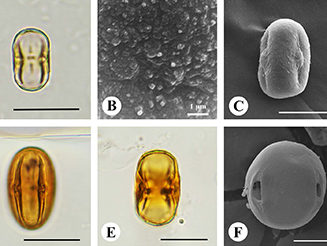Pollen morphology of the Sapotaceae from Thailand and its taxonomic implications
DOI:
https://doi.org/10.20531/tfb.2022.50.2.12Keywords:
morphometric analysis, palynology, Sapotaceae, taxonomy, EricalesAbstract
The external pollen morphology of the family Sapotaceae in Thailand was examined using the acetolysis method to determine its taxonomic significance. Pollen of 39 specimens belonging to 32 species was investigated by means of light and scanning electron microscopy. Pollen grains are found to be monads, isopolar, colporate, lalongate, and variable in size, shape, aperture number, colpus length and exine thickness. Exine ornamentation is also variable, showing more than one pattern on a single pollen grain. Principal component analysis based on 13 pollen characters identified three pollen groups: Chrysophyllum, Madhuca and Pouteria types based on pollen shape, size, the ratio of colpus length to the polar axis and exine sculpturing. Pollen morphology is taxonomically useful in the classification of the Thai Sapotaceae, especially in the taxonomic status of Planchonella and Pouteria species.
Downloads
References
Anderberg, A.A. & Swenson, U. (2003). Evolutionary lineages in Sapotaceae (Ericales): a cladistic analysis based on ndhF sequence Data. International Journal of Plant Sciences 164(5): 763–773. https://doi.org/10.1086/376818
Aubréville, A. (1964). Sapotacées. Adansonia 1: 1–157.
Ayensu, E.A. (1972). Morphology and anatomy of Synsepalum dulcificum (Sapotaceae). Botanical Journal of the Linnean Society 65: 179–187. https://doi.org/10.1111/j.1095-8339.1972.tb00932.x
Baehni, C. (1965). Mémoires sur les Sapotacées. 3. Inventaire des genres. Boissiera 11: 1–261.
Baillon, H. (1891). Histoire de Plantes: Sapotacées, Vol. 11. Libraire de L. Hachette, Paris, 255 pp.
Bentham, G. & Hooker, J.D. (1876). Genera Plantarum, Vol. 2. Reeve & Co., London
Chantaranothai, P. (2005). Sarcospermataceae. In: T. Santisuk & K. Larsen (eds), Flora of Thailand 9(1): 84–89. The Forest Herbarium, Bangkok.
Chantaranothai, P. (2014). Sapotaceae. In: T. Santisuk & H. Balslev (eds), Flora of Thailand 13(4): 610–655. The Forest Herbarium, Bangkok.
Chavent, M., Kuentz-Simonet, V., Labenne, A., Saracco, J. (2017). Multivariate analysis of mixed data: The PCAmixdata R package. R package version 4.
Christenhusz, M.J.M., Fay, M.F. & Chase, M.W. (2017). Plants of the world. Royal Botanic Gardens Kew, London.
de Candolle, A.P. (1844). Prodromus Systematis Naturalis Regni Vegetabilis. Fortin, Masson & Soc., Paris.
Dubard, M. (1912). Les Sapotacées de groupe des Sideroxylinées. Annales du Museé colonial de Marseille 10: 1–98.
Dubard, M. (1915). Les Sapotacées du groupe des Sideroxylinées-Mimusopées. Annales du Museé colonial de Marseille 3: 1–62.
Engler, A. (1890). Beitrige zur Kenntnis des Sapotaceae. Botanische Jahrbücher fur Systematik, 12: 496–525.
Erdtman, G. (1952). Pollen morphology and plant taxonomy. Angiosperm. Chronica Botanica Co., Waltham, Massachusetts.
Erdtman, G. (1960). The acetolysis method. A revised description. Svensk Botanisk Tidskrift 54: 561–564.
Faria, A.D., Pirani, J.R., da Silva Ribeiro, J.E.L., Nylinder, S., Terra-Araujo, M.H., Vieira, P.P. & Swenson, U. (2017). Towards a natural classification of Sapotaceae subfamily Chrysophylloideae in the Neotropics. Botanical Journal of the Linnean Society 185: 27–55. https://doi.org/10.1093/botlinnean/box042
Gupta, H.P. & Sharma, C. (1977). Palynotaxonomy and phylogeny of Indian Symplocaceae and Sapotaceae. Geophytology 7: 147–159.
Harley, M.M. (1986). Distinguishing pollen characters for the Sapotaceae. Canadian Journal of Botany 64(12): 3091–3100. https://doi.org/10.1139/b86-408
Harley, M.M. (1991). The pollen morphology of the Sapotaceae. Kew Bulletin 46: 379–491. https://doi.org/10.2307/4110538
Kunasit, P. & Chantaranothai, P. (2021). Pollen morphology of Sapotaceae-Chrysophylloideae from Thailand. Thai Journal of Botany 13(1): 59–67.
Lam, H.J. (1939). On the system of Sapotaceae, with some remarks on taxonomical methods. Receuil Travaux Botaniques Neerlandais 36: 509–525.
Pennington, T.D. (1991). The genera of Sapotaceae. Royal Botanic Gardens Kew, London.
Punt, W., Hoen, P.P., Blackmore, S., Nilsson, S. & Le Thomas, A. (2007). Glossary of pollen and spore terminology. Review of Palaeobotany and Palynology 143: 1–81. https://doi.org/10.1016/j.revpalbo.2006.06.008
Swenson, U. & Anderberg, A.A. (2005). Phylogeny, character evolution, and classification of Sapotaceae (Ericales). Cladistics 21: 101–130. https://doi.org/10.1111/j.1096-0031.2005.00056.x
Swenson, U. Bartish, I.V. & Munzinger, J. (2007). Phylogeny, diagnostic characters, and generic limitation of Australasian Chrysophylloideae (Sapotaceae, Ericales): evidence from ITS sequence data and morphology. Cladistics 23: 201–228. https://doi.org/10.1111/j.1096-0031.2006.00141.x
Swenson, U., Richardson, J.E. & Bartish, I.V. (2008). Multi-gene phylogeny of the pantropical subfamily Chrysophylloideae (Sapotaceae): evidence of generic polyphyly and extensive morphological homoplasy. Cladistics 24: 1006–1031. https://doi.org/10.1111/j.1096-0031.2008.00235.x
Swenson, U., Nylinder, S. & Munzinger, J. (2013). Towards a natural classification of Chrysophylloideae (Sapotaceae) in Oceania and Southeast Asia based on nuclear sequence data. Taxon 62: 746–770. https://doi.org/10.12705/624.11
Sowunmi, M.A. (1973). Pollen grains of Nigerian plants. I. woody species. Grana 13: 145–186. https://doi.org/10.1080/00173137309429891
Thiers, B. (2021, continuously updated). Index Herbariorum: A Global Directory of Public Herbaria and Associated Staff. New York Botanical Garden’s Virtual Herbarium. http://sweetgum.nybg.org/science/ih/
Walker, J.W. & Doyle, J.A. (1975). The base of angiosperm phylogeny: palynology. Annals of the Missouri Botanical Garden 62(3): 664–723. https://doi.org/10.2307/2395271

Downloads
Published
How to Cite
Issue
Section
License
Copyright (c) 2022 The Forest Herbarium

This work is licensed under a Creative Commons Attribution-NonCommercial-NoDerivatives 4.0 International License.


